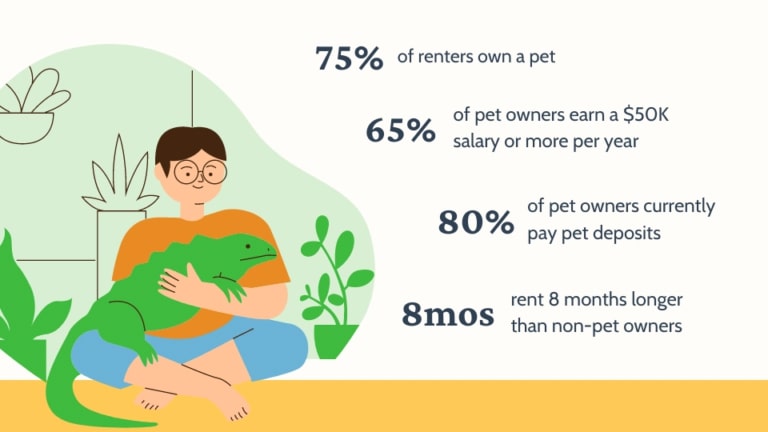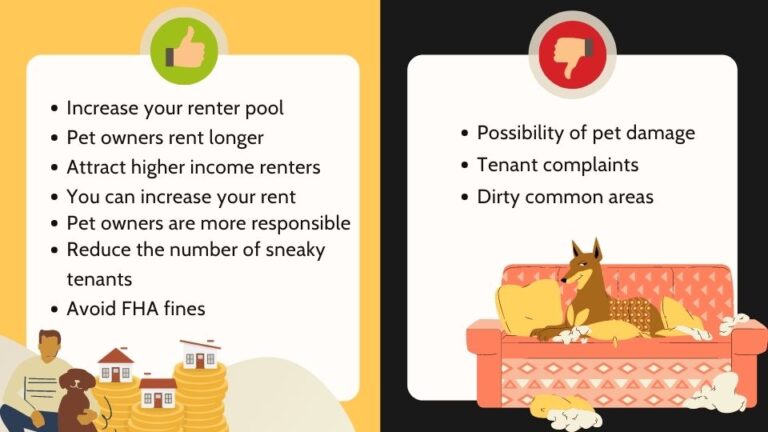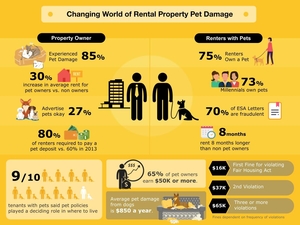As a landlord, you have to determine whether or not your rental properties are going to be pet-friendly. This can be a challenging decision due to the number of pros and cons. On one hand, allowing pets can dramatically increase the number of people interested in your rental. On the other hand, pets can inflict some severe damage to your property. Ultimately, the choice is yours, and we hope that the following guide will help you make your decision.
Pros
It Increases Your Renter Pool
As a pet-friendly property, you will dramatically increase your odds of showing up in a renters search. Studies show that 75% of renters own a pet which means you’ll be casting a wide net when you list your property on rental sites. For the average pet-owner, their pet is their family. No matter how incredible the rental is, they will always choose their pet over exciting amenities and a great location.
Pet Owners Rent Longer
Pet owners put their pets first. Relocation can cause a lot of stress to a pet, so owners typically try to avoid moving to ensure the comfort of their animals. It can be pretty challenging to move with pets, so renters prefer to avoid it if they can. On average, they rent for 8 months longer than non-pet owners. This will reduce tenant turnover and help to mitigate the risk of a vacant rental.
Attract Higher Income Renters
65% of pet owners earn a $50k salary or more per year. This reduces the risk of late or missed payments on your property.
You Can Increase Your Rent
There are many ways to increase your average rent for pet owners.
- Charge monthly pet fees per pet
- Charge a refundable deposit per pet. In your pet policy, indicate that any repairs or replacements resulting from pet damage will be deducted from their refund upon move out.
- Or, you can charge a smaller non-refundable per pet fee that is more appealing to renters. The amount may be lower, but you’re guaranteed to keep the deposit whether or not there is any damage done to the property.
- Charge a premium for offering a pet-friendly rental. Take a look at the pet-free rentals in your area and price your monthly rent slightly higher.
80% of pet owners currently pay pet deposits, so you won’t need to worry about being less competitive.

Pet Owners Are More Responsible
Pet owners often take better care of their rentals than non-pet owners. Owning a pet is a long-term commitment and requires the owner to be responsible. They’re so accustomed to cleaning up after their pet that they’re tidier in general. As a fail-safe, you can conduct pet and tenant screens. By contacting previous landlords, you can inquire about the behavior of the pet and the tenant to ensure they’ll be a good fit for your community.
Reduce The Number Of Sneaky Tenants
Landlords that don’t allow pets sometimes find themselves still having to deal with them. By not allowing pets, you do run the risk of tenants lying about having them and sneaking them into their rental. This can cause unnecessary headaches between you and your tenant should you find out, not to mention the damages to the property that could have been avoided. Not only will you have missed out on the pet rent and deposits, but you’ll also need to make the difficult decision of whether or not to evict your tenant.
Avoid FHA Fines
The Fair Housing Act requires landlords to accommodate tenants with service animals and emotional support animals. This applies to all rentals, not just pet-friendly ones. Violating this law will result in a $16k fine, and further violations fines can reach $65k or higher. Unfortunately, a reported 70% of the emotional support letters are fraudulent, so there’s no guarantee the pet is appropriately trained. By allowing pets, you’ll be less likely to run into these fraudulent activities and have policies in place to protect your property.

Cons
Possibility of Pet Damage
By accepting pets, you run the risk of them damaging your rental. Both cats and dogs can really shred a carpet. Pet stains and odors can be quite challenging to remove as well. Pet deposits will often cover these damages, but they can be pretty discouraging to have to fix. They also prolong the amount of time the rental will need to be vacant between tenants.
Tenant Complaints
Pets can be quite frustrating to your tenants that don’t have any of their own. Someone living next door to a barking or whining dog may call you repeatedly until you find a solution to the noise. It may increase the churn-out rate of tenants without pets that don’t want to deal with the noise for another year-long lease.
Dirty Common Areas
If there are common areas on your property for socializing or grilling, you may have to deal with lazy pet owners that don’t pick up after their animals. Unless you catch them in the act, you will either need to hire someone to clean up the mess or do it yourself. These messes will frustrate your other tenants and can turn into a headache for you as well.
Include a Thorough Pet Policy In Your Lease Agreement
Whether you choose to accept pets or not, it’s important to include a pet addendum in your lease that clearly states your pet policy and your expectations of the owner. All tenants should be required to sign the addendum, and they will need to disclose any new animals that they add to their household while in their lease. Make it clear that violating the terms in your policy is considered a breach of the contract.
The decision to accept pets in your rental properties should not be taken lightly. In addition to the responsibilities of being a landlord, managing pet-friendly properties comes with its own unique set of challenges. Whether you decide to make your rentals pet-friendly or not, after weighing the pros and cons, your next step is to create your pet policy to protect yourself.
OurPetPolicy can make the process easier. We’ll help you develop a pet policy that keeps you in compliance with the law, eliminates fraudulent emotional support animals, reduces the likelihood of damages, and offers easy management of your contracts with your tenants. Contact us today, and we’ll be delighted to assist you.

